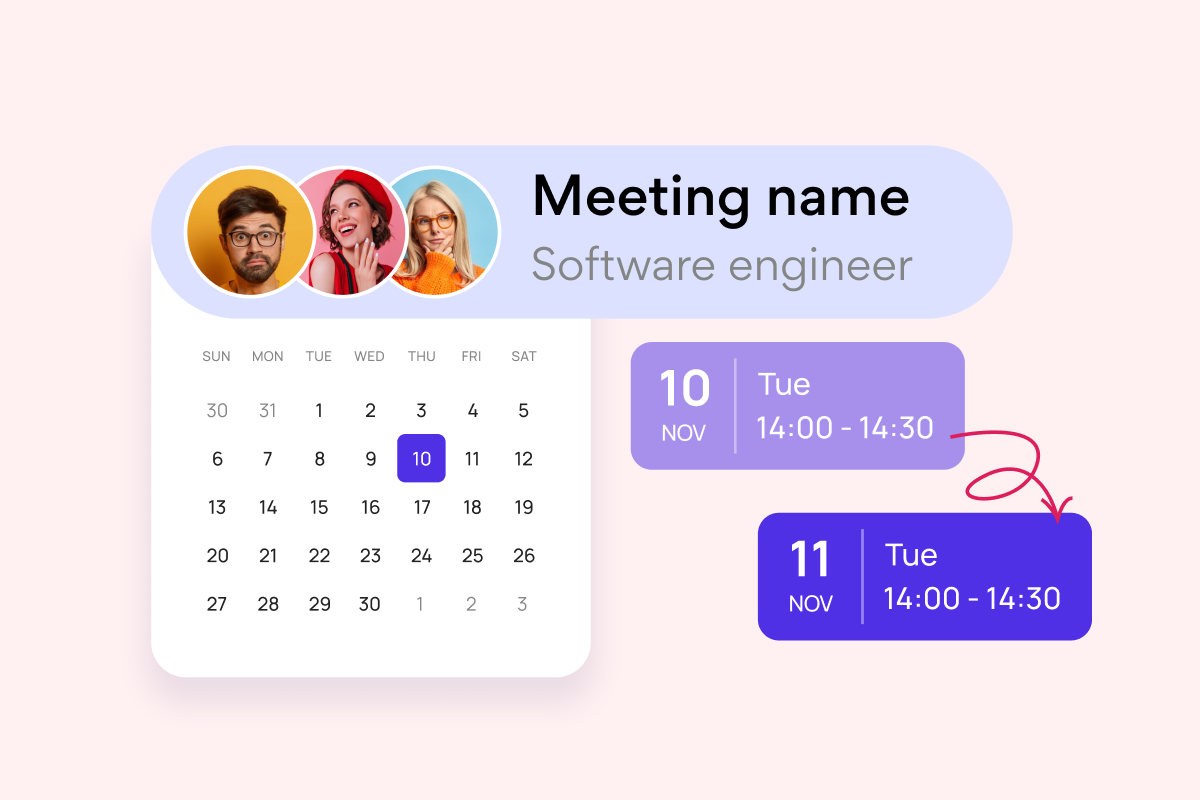Let’s be real—Agile without planning is like a GPS with no destination. Sure, you’re moving, but are you getting anywhere? That’s why clear planning and workflow visualization are at the heart of every successful Agile approach. Enter the sprint calendar—your team’s go-to tool for staying focused, aligned, and a few steps ahead.
A well-crafted sprint calendar acts like a shared GPS for your team, laying out the sprint schedule, flagging key milestones, and keeping everyone on track from one sprint to the next. Whether you’re leading a team or just trying to survive your second stand-up of the day, having a reliable sprint planning calendar makes life easier, projects smoother, and collaboration way less chaotic.
In this article, we’ll break down everything you need to know about building and using an effective Agile sprint calendar—what it is, how to set one up, the best tools for digital planning, and some hands-on tips to help your team use it like pros. Let’s turn that sprint chaos into a clear, confident plan.
What Is a Sprint Calendar and Why Does It Matter?
Agile is fast-paced, flexible, and… let’s face it, sometimes a bit chaotic. That’s exactly why having a clear, visual plan—aka a sprint calendar—is a total game changer. It brings structure to the chaos, helping teams move from “What are we even doing this week?” to “Let’s crush this sprint.”
The sprint calendar and its role
So, what exactly is a sprint calendar? In simple terms, it’s not just a regular calendar with some fancy labels—it’s a specialized tool used in Agile frameworks like Scrum to plan, visualize, and track work cycles known as sprints. Think of it as the control panel for your team’s sprint rocket.
Unlike your standard Google Calendar filled with birthdays and dentist appointments, a sprint calendar is built with purpose. It’s designed to highlight everything that goes into an Agile sprint: from start and end dates, to crucial events like sprint planning, daily stand-ups, reviews, and retrospectives. It gives your team a crystal-clear view of the sprint’s heartbeat—so everyone’s in sync and no one’s left guessing what happens next.
Here’s why a good Agile sprint calendar is your team’s best friend:
- Sprint planning made visible: you get a visual layout of when sprints begin and end, what goals are set, and how tasks are distributed.
- Deadline tracking without the panic: a good sprint planning calendar keeps everyone aware of what’s due when, and what’s happening each day.
- Team alignment, on point: with one shared sprint schedule, everyone knows when meetings happen, what checkpoints to expect, and what the current priorities are.
- All the Agile rituals in one place: from planning to demos to retros—your team’s ceremonies are all laid out in the calendar, no sticky notes required.
This kind of visibility doesn’t just make life easier—it boosts project transparency and helps everyone stay ahead of the curve. Whether you’re all sitting in the same office or spread across five time zones, a centralized sprint calendar helps every team member prep for important moments and keep their work in rhythm with the rest of the crew.
In a nutshell? A sprint calendar takes your Agile process from “we think we’re on track” to “we know we’re on track.”
????What is a sprint calendar? What is sprint calendar in Agile? A sprint calendar is a visual tool used by Agile teams to plan and track what happens during a sprint—from start and end dates to meetings, task deadlines, and key milestones. It helps everyone stay aligned and know what’s happening, when. In Agile (especially Scrum), a sprint calendar maps out the flow of each sprint, including planning, daily stand-ups, reviews, and retros. It keeps the team organized, improves transparency, and makes sure no one misses a beat—whether you’re all in one office or spread across the globe.
Understanding the sprint timeline
Now let’s zoom in on the sprint timeline itself. In Agile, a sprint is a short, focused chunk of work—usually lasting anywhere from 1 to 4 weeks—where a team tackles a specific set of tasks. And just like any good story, each sprint follows a familiar rhythm:
- Sprint planning: the team sits down and decides what work they’re going to commit to. This is where the goals are locked in.
- Daily stand-ups: quick syncs (usually 15 minutes) where everyone shares what they did, what’s next, and if anything’s blocking their progress.
- Heads-down work time: the main event—where tasks are executed, bugs are squashed, and progress gets made.
- Sprint review (demo): a show-and-tell of what’s been built. Stakeholders get to see what’s ready and give feedback.
- Sprint retrospective: a moment to reflect—what went well, what didn’t, and how the team can get even better next time.
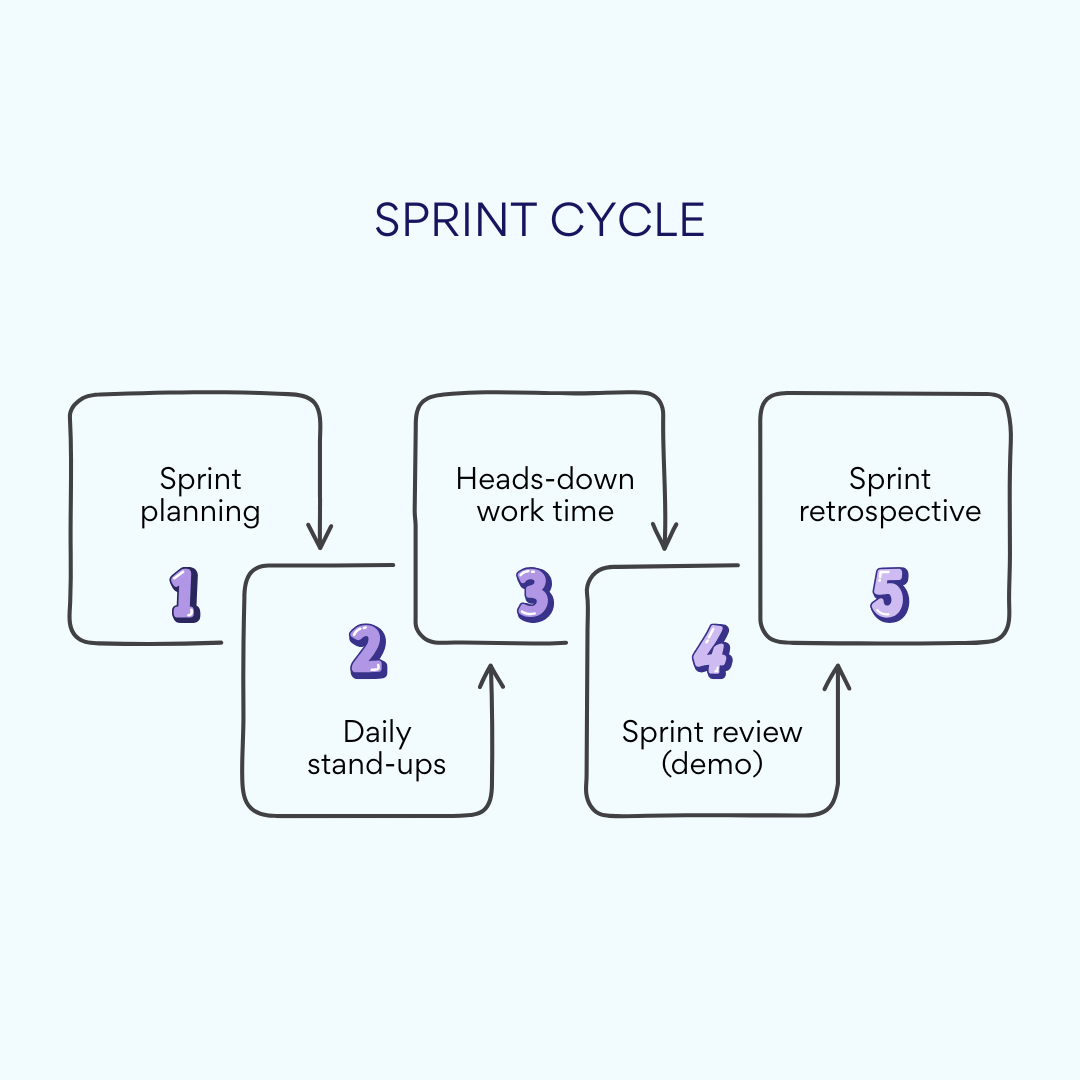
This cycle repeats sprint after sprint, forming the backbone of Agile’s continuous, iterative development process. The sprint timeline is what gives the team its rhythm—predictable, structured, and endlessly adaptable.
????What is the sprint timeline in Agile? The sprint timeline in Agile is the structured timeframe—typically 1 to 4 weeks—during which a team works to complete a defined set of tasks. It follows a consistent rhythm: starting with sprint planning to set goals, followed by daily stand-ups for quick check-ins, focused work sessions to deliver the sprint backlog, and ending with a sprint review to showcase progress and a retrospective to reflect and improve. This repeating cycle is the heartbeat of Agile, driving continuous delivery and team growth.
How to Create and Use a Sprint Calendar
Creating a sprint calendar isn’t just about picking some dates and slapping them on a calendar app. It’s about building a reliable structure your team can count on—something that keeps everyone aligned, deadlines visible, and priorities clear. Whether you’re new to Agile or just tired of chaotic sprints, setting up a thoughtful sprint planning calendar can seriously level up your workflow.
Let’s walk through how to create one that actually helps—not hurts.
How to make a sprint calendar
So, you’re ready to build a sprint calendar—awesome choice. It’s the kind of tool that turns scattered ideas into a clear, team-wide sprint schedule. Here’s how to put one together that actually works:
⏱️Decide on the sprint length
First things first: pick your rhythm. Most Agile sprint calendars run on a 2-week cycle, but anything from 1 to 4 weeks is fair game. The key is consistency—same duration, every time, so the team gets into a predictable flow.
????Set your start and end dates
Look at weekends, holidays, and team availability. Then, block those sprint dates in your calendar. It gives your team a solid frame to plan around—and avoids nasty deadline surprises.
????Schedule key events
Every sprint planning calendar needs the core Agile rituals baked in from the start:
- Sprint planning: day one—this is your launchpad
- Daily stand-ups (daily scrum): quick syncs, same time every day
- Sprint review: end of the sprint—time to show what you’ve built
- Sprint retrospective: right after the review, or the next day—reflect, improve, repeat
Drop all of these into the calendar upfront to keep everything smooth and conflict-free.
????????Break down tasks and assign owners
Link your sprint calendar with the sprint backlog. For each task or user story, add a deadline and assign someone responsible. It keeps work visible and accountability clear.
????Sync with your team before kicking off
Before the sprint starts, gather the team for a quick check-in. Walk through the calendar, align on goals, clarify roles, and make sure everyone’s rowing in the same direction.
????How to make a sprint calendar? To create a sprint calendar, start by defining your sprint length (usually 1 to 4 weeks) and set consistent start and end dates. Add key events like Sprint Planning, daily stand-ups, Sprint Review, and Sprint Retrospective. Break down tasks, assign owners, and sync with your team to ensure everyone is aligned. Use tools like Trello, Jira, or Google Calendar to keep everything organized and up-to-date. A well-structured sprint calendar helps keep the team on track and improves planning.
Improve Your Sprint Calendar with Virto Apps
Tools for Your Sprint Calendar
With the right tools, you can streamline your sprint planning calendar, make sure everything is synced up, and keep the whole team on track. Plus, digital tools often come with handy integrations, automatic updates, and the flexibility to manage your calendar on the go. Let’s take a look at some of the most popular options out there.
Popular tools for sprint calendars
Here’s a rundown of some of the most popular tools out there that are perfect for managing your Agile sprint calendar:
Google Calendar + Task Tracker Integrations
Super simple to use and free! Create separate calendars for each project or team and integrate with tools like Trello, Asana, Jira, and Slack. It’s ideal for scheduling meetings, setting reminders, and keeping everything synced.
Outlook Calendar (part of Microsoft 365)
If your company is already using Microsoft 365, Outlook Calendar is a natural choice. It integrates with Teams, To Do, SharePoint, and Planner. Plus, it lets you share calendars with your team and manage tasks and events easily. You can also view schedules with time zone support—handy for global teams!
Jira (Agile Board + Calendar View)
One of the top choices for Agile teams. With built-in Scrum boards and support for sprints, backlogs, and epics, Jira is made for Agile workflows. Add plugins like Team Calendars to view your sprint schedule in a calendar format and keep everything synced with tasks and team progress.
Trello with Power-Ups (like Calendar)
Perfect for teams who love a visual approach. The Calendar Power-Up lets you view your task cards in a calendar view, making it easy to track deadlines, labels, and checklists. It integrates seamlessly with Google Calendar, Slack, Microsoft Teams, and more.
Teamup Calendar
Ideal for smaller teams, nonprofits, or startups. Teamup doesn’t require logins or complicated setups, and you can create a calendar for each project or sprint. It offers flexible access levels (view, add, edit), making collaboration a breeze.
Microsoft Teams + Virto Calendar App
If your team lives in Microsoft Teams, then the Virto Calendar App is your friend. It allows you to visualize tasks, events, and meetings in daily, weekly, or monthly views. Plus, it syncs with Outlook, SharePoint, and task lists, helping keep everything in one spot.
????Want more insights into tools to align remote teams? Check out our guide Collaboration Tools for Remote Teams to Enhance Productivity and Engagement
Benefits of digital tools
There are some serious perks to using digital sprint calendars:
✅Collaboration & transparency
With digital tools, everyone on the team has access to the latest version of the calendar. You can assign tasks, see who’s working on what, and ensure everyone’s on the same page. It’s all about improving team synchronization.
✅Integrations with task-tracking tools
Digital calendars sync effortlessly with your task tracking tools (like Jira, Trello, Microsoft Planner), automatically updating deadlines, statuses, and reminders. This means you’ll never miss a deadline or a meeting.
✅Notifications & visuals
Set up reminders for meetings, task due dates, retrospectives, and more. Plus, you can visually track where your team might be overloaded or have gaps in their schedule, which is a game-changer for project management.
✅Access anywhere
Whether you’re using a mobile app or desktop version, digital tools make it easy to stay connected to your sprint calendar and tasks from anywhere, anytime.
How to Organize Your Sprint Schedule for the Year
Planning your sprint schedule for the year might sound like a lot, but it’s the key to setting your team up for long-term success. A yearly view of your Agile sprint calendar helps your team align with other departments, account for external factors, and avoid burnout by managing workload and timing better. So, how do you map out your sprints for the whole year?
How many sprints in a year?
The number of sprints you can fit into a year depends on how long each one lasts. The most common length is 2 weeks, but some teams prefer 1-week, 3-week, or even 4-week sprints. Here’s an example calculation for the classic 2-week sprint:
52 weeks / 2 weeks = roughly 26 sprints in a year.
But remember, with holidays and team vacations, you’re realistically looking at 22 to 24 full sprints.
And here’s the key: make sure sprints run back-to-back, with no gaps, except for official breaks like the holiday season or planned time off.
What to consider when planning your yearly schedule
Now, let’s talk about the factors that affect your sprint schedule over the year:
- Holidays and Weekends
Don’t schedule the start or end of a sprint during holidays. Avoid planning important events like retrospectives or demos on weeks with fewer working days. - Vacations and seasonal breaks
Keep an eye on key team members’ vacation schedules—summer and winter breaks are common. During these times, try to schedule less critical tasks so you’re not left scrambling. - Business events & dependencies
Coordinate your sprints with major business milestones—like product releases, marketing campaigns, trade shows, or conferences. Also, factor in external dependencies—if you’re waiting on a design from another team, it’s essential to have that reflected in your calendar. - Buffer zones & planning time
At the end of each quarter or year, it’s a good idea to leave at least one sprint as a buffer—this could be for reflection, tackling tech debt, or working on team-driven initiatives. You can also dedicate a sprint to planning for the upcoming period.
Real-world example of an annual sprint schedule
Here’s what an Agile sprint schedule might look like for a year with 2-week sprints:
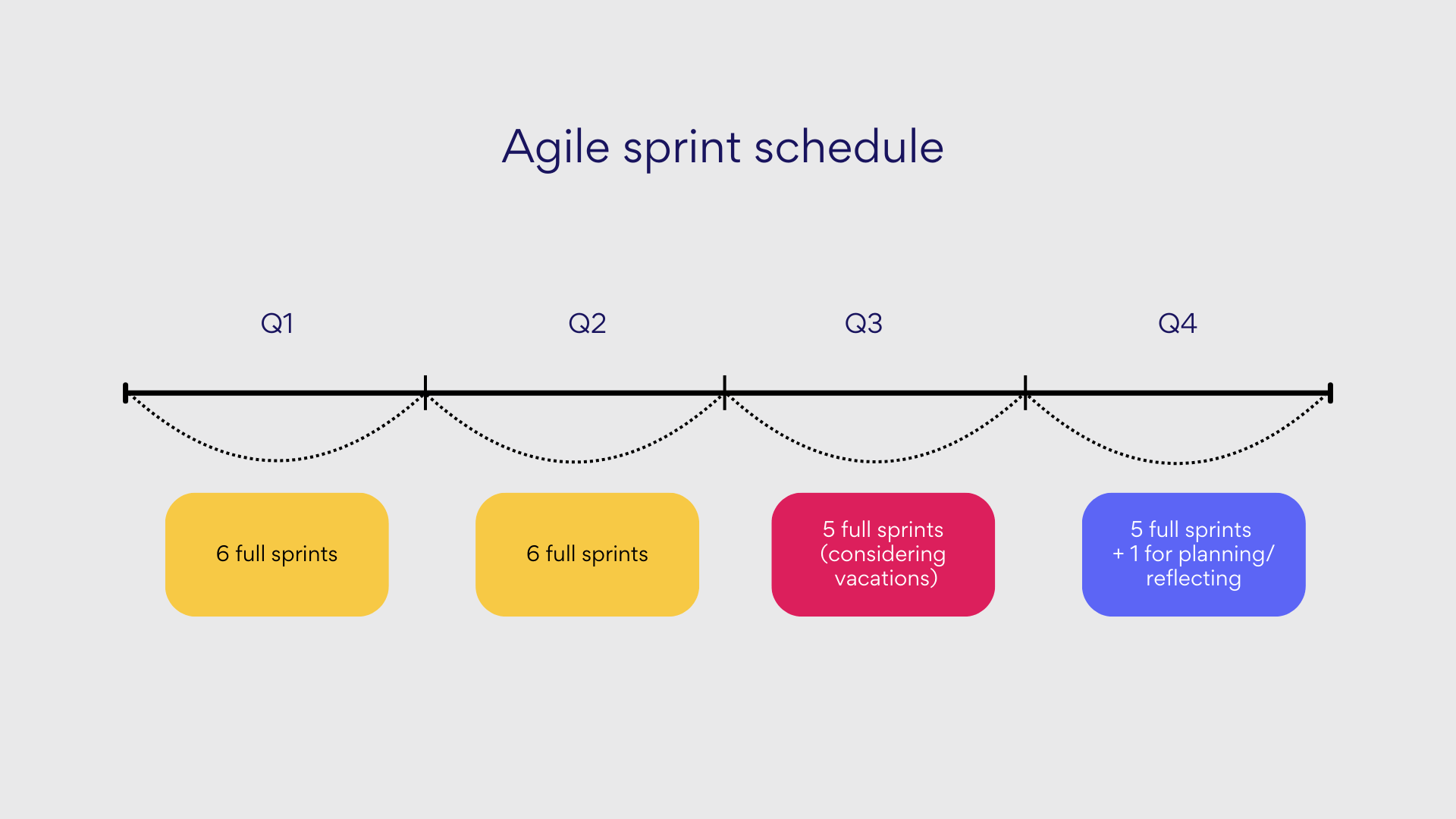
This setup allows for steady progress, while also being flexible enough to accommodate holidays and other key business events.
????How many sprints are there in a calendar year? In a typical year, with 2-week sprints, there are about 26 sprints. Taking into account holidays and vacations, 22-24 sprints is a more realistic number. The count will vary if your sprint duration is longer or shorter.
Explore Our Use Cases for Sprint Calendar
Practical Tips for Using Your Sprint Calendar
Let’s dive into some practical recommendations to help your team get the most out of their sprint calendar and stay on top of everything from daily stand-ups to retrospectives:
For your team:
| Assign a calendar owner | Choose someone (Scrum Master, Project Manager, etc.) to keep the sprint calendar updated and synchronized with other systems. |
| Use color-coding for events | Color-code key events for easy navigation: Sprint planning – BlueDaily meetings – GreenDemos – PurpleRetrospectives – RedExternal dependencies – Yellow |
| Tie retrospectives to the calendar | Schedule retrospectives and capture summaries on improvements and issues to track team progress over time. |
| Integrate your calendar into daily work | Add the sprint calendar to Slack, Teams, Trello, or Jira so all team members have easy access without barriers. |
| Periodically clean and update the calendar | Regularly remove outdated events, archive completed cycles, and update templates/formats for clarity and efficiency. |
For project managers & leaders
| Maintain sprint consistency | Stick to a regular sprint rhythm (e.g., bi-weekly). If adjustments are needed (holidays, demos), ensure they’re well-justified and communicated. |
| Ensure transparency across departments | Make the sprint calendar accessible to all departments (product managers, analysts, marketing, etc.) to reduce follow-up questions and build trust. |
| Use the calendar for reporting | Log sprint achievements, challenges, and demo feedback to simplify project reporting, especially for distributed teams. |
| Promote a culture of accountability | Make sure everyone knows their responsibilities within each sprint to avoid confusion and improve team collaboration. |
| Combine with analytics tools | Sync the sprint calendar with visualization tools like burn-down charts to track progress and stay proactive about potential issues. |
Virto Productivity Tools for Agile Teams: A Convenient Solution for Sprint Planning
Virto offers a suite of powerful productivity tools that extend the Microsoft 365 ecosystem, helping Agile teams streamline sprint planning, manage availability, and collaborate more efficiently — all within Microsoft Teams. Whether you’re organizing sprints or sharing availability across a hybrid workforce, Virto tools bring clarity, speed, and integration to your workflow.
Virto Calendar App: visual sprint planning in Teams
Virto Calendar App is an extension of the Microsoft 365 ecosystem, designed to create powerful, visual calendars directly within Microsoft Teams. Its functionality makes it an ideal solution for planning and managing Agile sprints.
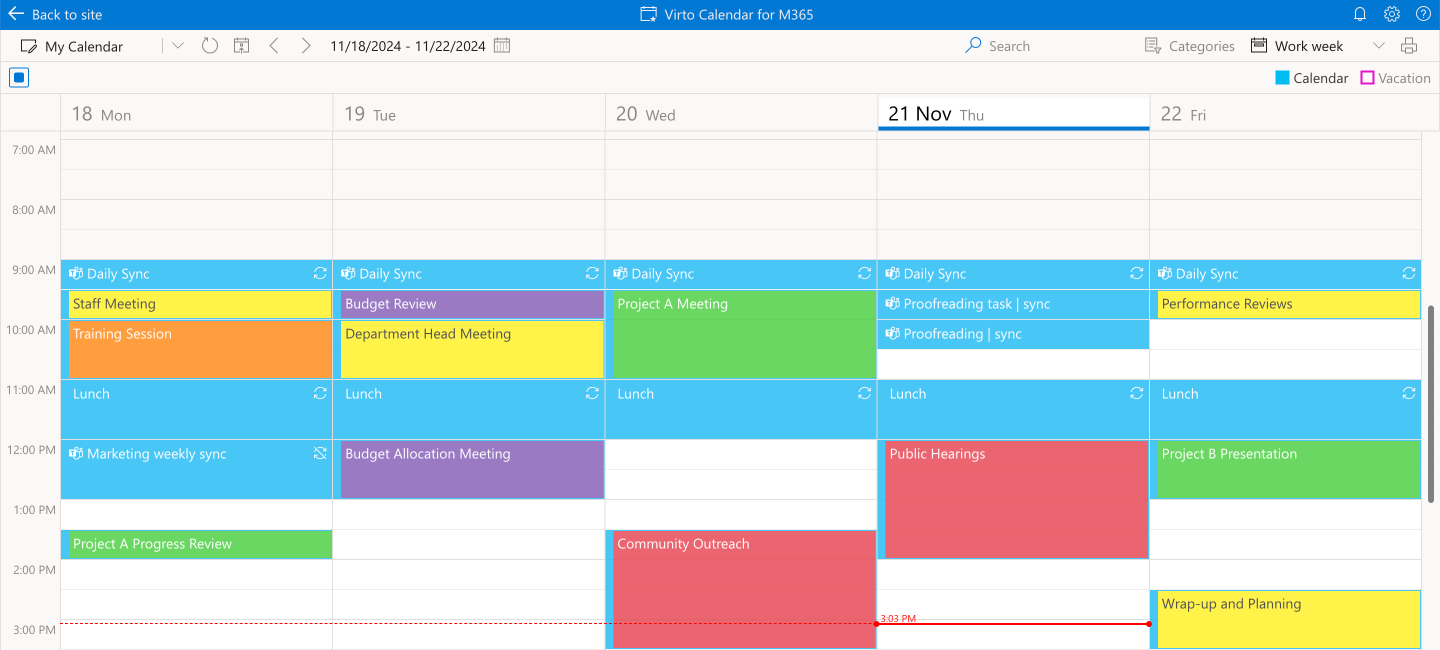
Here’s how Virto Calendar App stands out for sprint planning:
- Flexible calendar views: switch between daily, weekly, monthly, or list views to adapt the calendar display according to the sprint phase or team preferences.
- Custom categories and color labels: categorize events (e.g., planning, daily stand-ups, demos, retros) and assign colors for quick and easy navigation through a busy schedule.
- Collaboration within Teams: Edit events collaboratively, chat about them, and link tasks, documents, and boards directly in Teams. No need to switch between apps — everything is available in one place.
- Visual segmentation and filters: quickly filter the calendar by event type, status, participants, or categories, making it ideal for multifunctional or distributed teams.
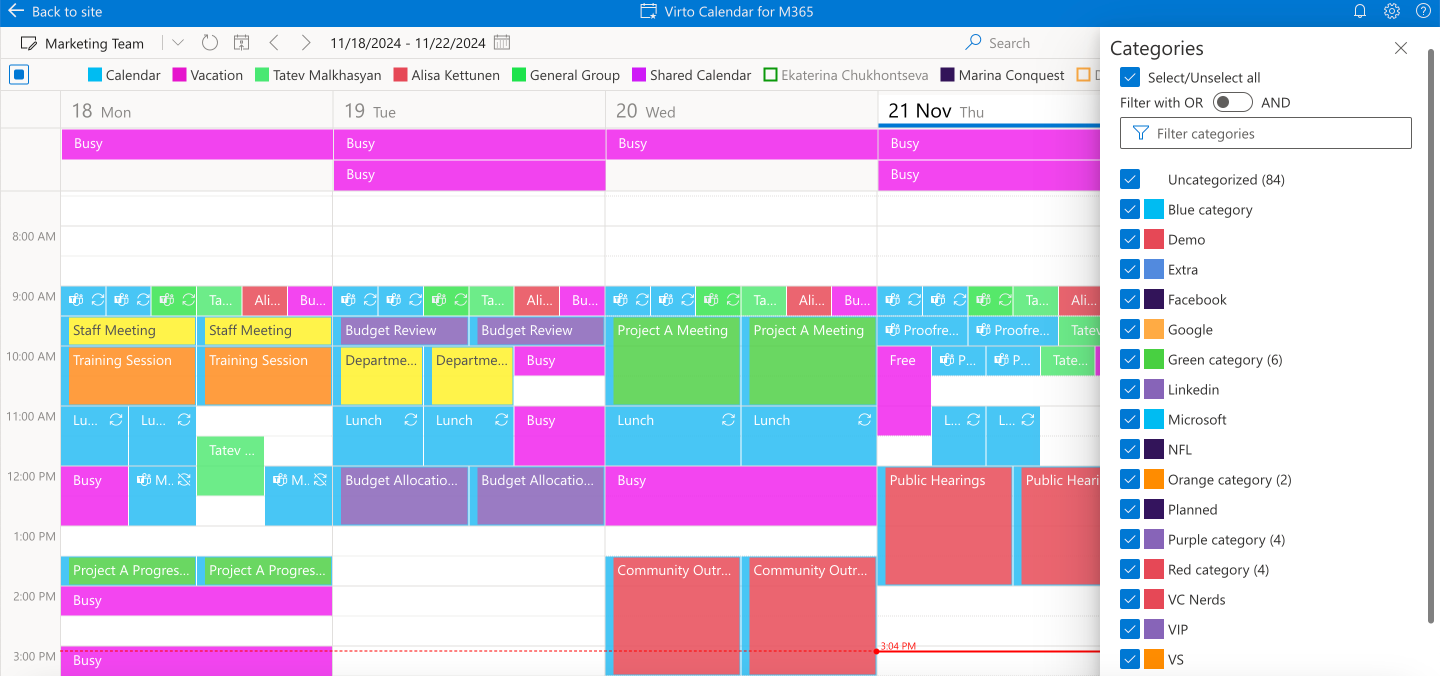
Benefits of Virto Calendar App for Teams
Virto Calendar App offers several key advantages, including:
✅Seamless integration with Teams: the calendar works as a tab within Microsoft Teams, allowing teams to plan and coordinate without switching between systems.
✅Connection to SharePoint and Outlook: events can sync with other Microsoft services, streamlining document workflows. For example, link a sprint to a SharePoint folder where all the relevant work documents are stored.
✅Easy time zone management: set and display meeting times across multiple time zones, which is crucial for international and remote teams.
✅Deep integration with Microsoft 365: Virto Calendar App syncs with tasks, notes, chats, and files. You can assign tasks, attach documents, and quickly jump to relevant discussions directly from the calendar.

Virto Shared Calendar: real-time availability made easy
Virto Shared Calendar isn’t just for booking rooms or meetings — it’s a powerful tool to streamline sprint planning and team coordination. Its real-time visibility and flexible customization make it a valuable asset for Agile teams working in fast-paced or distributed environments.

Here’s how it supports sprint planning:
✅ Effortless availability sharing
Make sprint planning sessions, retros, or demos easy to schedule by showing real-time team availability directly in your workspace — no emails, no back-and-forth.
✅ Visibility of sprint events
Display open slots for ceremonies like backlog grooming, daily stand-ups, and reviews, so everyone knows what’s coming up and when they’re expected to engage.
✅ Instant updates, centralized view
When sprint events shift, your calendar updates instantly across Teams and the web — keeping everyone aligned without extra coordination.
✅ Tailored sprint views
Filter availability by team, role, or project — ideal for multi-team Agile environments where parallel sprints run on different tracks.
✅ No-login access
Share sprint calendars with external partners or clients without requiring access credentials — perfect for product demos or milestone reviews.
Whether you’re planning across time zones or juggling multiple sprint teams, Virto Shared Calendar simplifies coordination and gives Agile teams the transparency they need to stay on track.
Final Thoughts
A sprint calendar is more than just a schedule — it’s a key planning and management tool in Agile teams. It helps establish a consistent sprint rhythm, avoid chaos, stay organized, and deliver results on time.
Modern digital tools like Virto Calendar App make sprint planning and visualization easy, clear, and seamlessly integrated into everyday workflows. This is especially valuable for hybrid and distributed teams where centralized planning and transparency are essential for effective collaboration.
We recommend trying Virto Calendar App as a powerful and convenient sprint planning tool, especially for teams working within the Microsoft 365 ecosystem.
????Want to see how this works in a real team? → Check out our use case Agile Project Management
????Looking to optimize team collaboration further? → Explore our guides:
